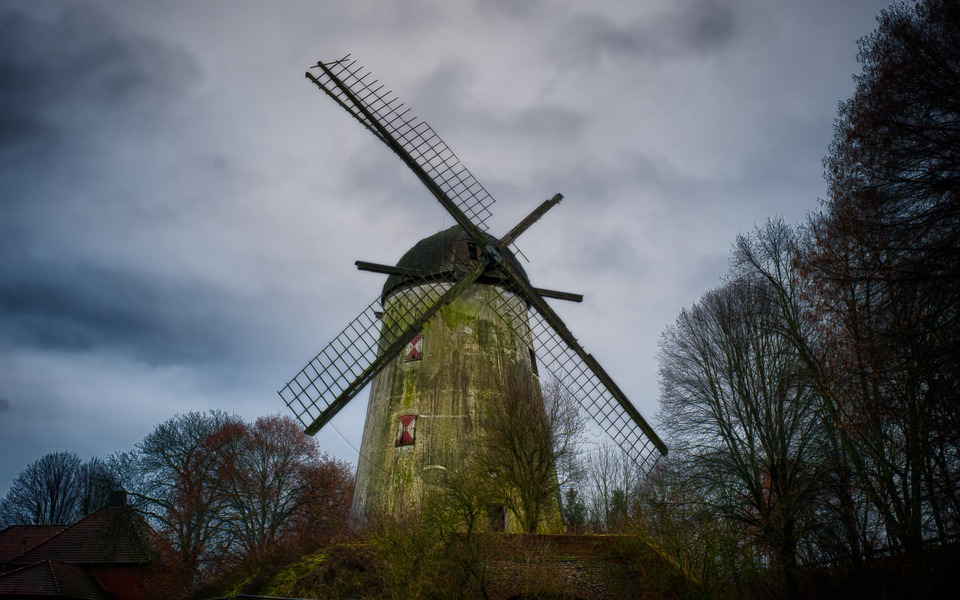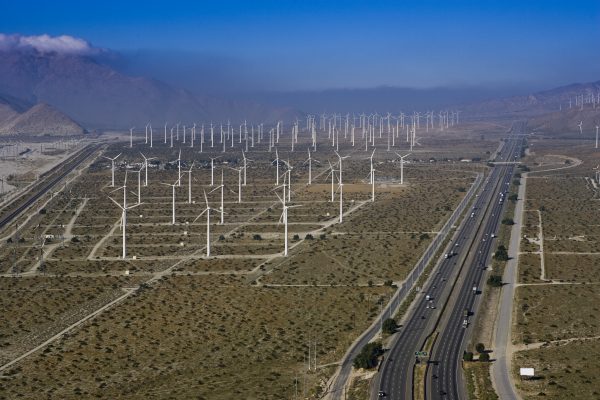“He that troubleth his own house shall inherit the wind.”
That’s the warning in Proverbs 11:29, advice that relies upon common knowledge that there is no tangible value to the wind. One cannot hold or possess moving air, after all, and even if one could, too much gas moves in too many places to give it value. The Mistral, Scirocco, Santa Ana, and Nor’easter have never been scarce. But on the Spanish side of the Strait of Gibraltar, where I conduct ethnographic fieldwork, the Levante and Poniente power multiple wind farms, generating electricity for the region of Andalusia.
To save ourselves from catastrophic climate change, we have to rethink who owns the wind.
Spain’s largest green energy firms pay rent to landowners, some of whom are in possession of estates of feudal proportions, for the access roads and clearings around each turbine. The landowners also collect revenue based on a derecho del aire, or air right, a privilege that did not exist a few years ago. Suddenly—and almost without challenge—farmers, ranchers, and their business partners now generate sizeable income from the wind, the equivalent of royalties for oil and minerals. The famously and proverbially excessive wind is becoming exclusive.
As we attempt to move towards a future with more wind energy, there is no avoiding the once outlandish question: who owns the wind? Is it a public or a private good? As we try to transition away from fossil fuels, these questions will determine the shape and the very possibility of our energy solutions.
•••
In a tiny, 400-person village I will call Sereno, turbines begin just past the last house and run in serpentine lines through wheat, sunflower, and cattle fields. At various points since 1999, since they were first installed, Sereneños have tried to stop the erection of more machines, but the people lost and now live with the unwelcome sights and sounds of 250 steel giants. Many have adjusted to the technological aesthetic, but almost no one accepts the division of benefits. Unlike some community managed wind farms on public land in Germany and central Spain, these turbines sit on private property. Private parties, therefore, reap all the reward. Corporations and allied landlords are cashing in while Sereneños still pay for their electricity.
That lopsided outcome has deepened an abiding class-based resentment. One Saturday, I join a party at the Mesón de Toreros, a one-room bar tucked into a side street. Men drink beer while women cook sausages out back. Bullfighters line the walls, memorialized in posters of the major fights in Seville, Granada, and Madrid. I mention the name of a large landowner in the area, Ricardo Soares (a pseudonym, as are all the names below), who raises bulls for the ring. One might have expected to find him at the Mesón de Toreros. But my drinking mates have nothing but spite for Ricardo. He is more “cafre” than any other landlord, they say, using a dated racist term for Africans that now translates as “brute.” Soares doesn't sell his bulls for profit, nor does he employ a large workforce or share his land with others who might put it to use. His largest farm, Bugaba (also a pseudonym), doesn’t even produce crops. Instead a wind company pays Ricardo an annual fee for access to the breeze blowing over his land. “He lives from the turbines,” the men in the bar say.
The problem of land concentration is nothing new in Andalusia. In the first and second centuries before the Common Era, Rome’s leading families took control of latifundia, the Latin term for large estates. After Rome fell, Muslim Moors occupied Iberia and farmed it successfully, but then history repeated itself. Christians conquered—or, as they said, reconquered—the peninsula, with the final phase of the Reconquista taking place in Andalusia from the thirteenth century to 1492. Kings subsidized noblemen and knightly orders who pillaged and held territory. Dukes and marquises closed up the countryside even though there weren’t enough of them to cultivate more than a fraction of it. The Moors’ elaborate irrigation systems—some derived from the Romans—fell into disrepair and then disappeared entirely. Real estate in Andalusia, it seems, has always perpetuated violence, exploitation, elitism, and waste—the four horsemen of rural Spain’s enduring social apocalypse.
We are managing airborne energy as if it were an old-fashioned fossil fuel, applying an underground logic to the sky.
By the time the agronomist Pascual Carrión surveyed the scene in 1932, breadbaskets had become arid wastelands. Borrowing a term from Spain’s former empire, he called these large, partitioned estates latifundios, owned by latifundistas. In the municipality containing Sereno, Carrión found that latifundistas held 70 percent of a zone containing thousands of inhabitants. The rural poor mostly lived in squalor: building shacks in the stony mountains and uplands, working as seasonal day laborers on the latifundios, and simply going hungry. Many begged for employment and alms from the single extended family who owned fifteen of those twenty nine estates: the Soares family. No wonder my friends in the village excluded Ricardo from the Mesón de Toreros.
Ricardo descends, across eight generations on the male line, from Jaime Soares y Pizarro, the first ancestor to live in the area. That eighteenth century man established the genetic resources for a storied strain of bovine animals, and ever since, the family has raised cattle, irrigating almost nothing, planting very little, and employing very few. Ever a rancher, Ricardo has eschewed political office, feeling—as he writes in a family biography—“a debilitating obsession with the bull.” Yet, Ricardo cannot escape his status as a latifundista and his lineage of caciques, or political bosses. The Spanish Empire—lingering through inequality and resentment—lives where it began, in Andalusia.
•••
I meet Ricardo Soares one October evening at Sereno’s most popular bar and restaurant. He is commandingly tall, well over six feet, and seems accustomed to deference. A traditionalist, he supports Church, Crown, and Conquistadores, the latter for their courage and cojones. He rolls and chain-smokes his own cigarettes, and he prefers local food and tapas with only one ingredient. At the restaurant he orders decisively and without looking at the menu. At home he dines on bulls raised for the ring but not quite vicious enough to kill a man: “black, ecological, autochthonous, the best meat in the world.”
I have to press Ricardo to discuss something so untraditional and un-bovine as wind power. Fortunately, he explains, the bulls have adapted to the towers and blades, even seeking out their shade. But Ricardo’s farm is a vanity, he admits. When I ask him what keeps Bugaba profitable, he turns his hand like a fan. “Disgracefully,” he admits, the insult against him is true. Without turbines, Ricardo would have to subdivide and sell off arable portions of his land.
In the United States landowners possess subsurface rights to oil, gas, minerals, and so on. A company that wishes to extract that oil will pay the landlord royalties as well as rents for any surface area taken up by the production itself. This is the model being used for Ricardo’s wind farms as well, managing airborne energy as if it were an old-fashioned fossil fuel and applying that underground logic to the sky. In the standard deal, a landowner like Ricardo earns an annual rent for the footprint of a turbine and the pad around it, about half the size of soccer field. Then, the landholder receives a second payment proportional to the value of the electricity produced by each turbine. Fortunately for him, Ricardo negotiated a sophisticated version of the twin-payment arrangement, one that also indexes the rent to inflation.
Such a contract is unprecedented in Sereno’s land deals. In the past, if someone wanted to use another’s land, he paid either an annual fee or a portion of the crop, not both. When I ask Ricardo about the royalty and if he feels entitled to it, he categorizes the Levante as a commons. “The wind is not mine,” he explains, “it passes.” Air is a “public good,” like water. “I understand this through humanistic philosophy,” Ricardo says, implying that humanism is not his usual perspective. But when the wind falls, he says, one can appropriate it.
The Spanish Empire—lingering through inequality and resentment—lives where it began, in Andalusia.
We focus on this verb, fall, which in Spanish also means “to befall” or “occur.” The wind befalls or arrives unbidden, but it does not fall vertically from the sky. It flows more or less horizontally, like a river, across property lines. So maybe the wind, like water, could function as a highly regulated commons, shared by valley neighbors for irrigation and other services. In Spanish water law, as in the most of the world, the landowner cannot extract all the water crossing his or her land. Upstream users must cede rights to downstream users, lest the lower valley dry out.
Air does flow more than it falls, but it does not flow exactly like water. Ricardo and I puzzle this out over mixed drinks and unmixed tapas. Wind is abundant. As far as we can see, one turbine does not subtract from the kinetic force available to the next one downwind. Nevertheless, Spanish law establishes a minimum buffer of turbine-free land around each wind farm. “Dirty wind,” as sailors call it, must recuperate itself before the encounter with blades or sails. Ricardo cannot fill his acreage with turbines up to the boundary fence. We agree on this small limitation to private property, this one concession to the commons, and after brushing off a woman who tells him not to smoke indoors, Ricardo ends all debate. The wind, he says, belongs to “the one who puts up the first turbine.” He also answers the more sophisticated form of my question about the right to kinetic forces. The breeze above Bugaba, as he refers to it in passing, is “my 48 megawatts.”
Those 48 megawatts have allowed Ricardo to keep his latifundio whole, not parceled out to smaller farmers who might make good use of it. Sometimes, the more things change, the more they stay the same.
•••
A rising subset of wind wonks has endorsed the Soares-style latifundios model. By formalizing conventions that already exist in the oil industry, they would implant petroleum’s worst forms of finance on a latifundista land base. Earlier this year, for instance, Travis Bradford—a hedge-fund manager turned eco-capitalist—published a report entitled “Financing solar and wind power: insights from oil and gas.” The study pinpoints abundance as a problem. “Scarcity of usable solar and wind resources,” write Bradford and his co-authors, “is necessary to give them substantial value.”
That is an understatement. In wind alone, an almost unimaginable 2,200 terawatts course through the atmosphere. One might exclude 1,800 of those as too high up for turbines to reach, but 400 terawatts blow in the lowest layer. Even if one limited wind farms to places—like the Strait of Gibraltar—where onshore and near-shore breezes blow fast and steady, the industry could produce 72 terawatts. The entire human species only consumes 18 terawatts of energy for all its purposes. Supply dwarfs demand.
The architects of air rights don’t want the wind industry to flourish—they plan for turbines to fail ecologically while succeeding economically.
The wind industry—including turbine operators and landowners—may have to sell electricity for cheap. There is a solution though, according to people like Bradford—an artificial means of tightening supplies that the oil industry has used. Oil is plentiful, after all, but oil companies describe crude using two terms: resources and reserves (as in “proven reserves”). The first category refers to the oil that actually exists. Much of it is found in rock too deep, too tough, or too far offshore to drill easily. The second category, “reserves,” refers to the shallow or otherwise accessible oil that can be extracted for a profit now. By drilling only reserves therefore, companies such as ExxonMobil guarantee themselves a healthy bottom line.
The outlook may improve further still. Reserves sometimes suffer from what the industry calls “above-ground risk,” that is instability or violence in the given country. War can reduce reserves and enlarge resources. The U.S. invasion of Iraq, for instance, took wells out of production, lowering supply and raising gas prices. Oil companies took that money to the bank. Could something similar happen in the wind industry? As Bradford promises, “Community, political, environmental, and similar barriers to development . . . [will] take many potential sites out of the market.” With their early protests against more turbines, it seems, Sereneños could be considered an above-ground risk.
Between the lines, one can anticipate a political strategy: this class of eco-capitalists will promote some wind farms and then surrender easily to their enemies, the local communities that have tended to oppose or curtail turbines and panels. An invasion of protestors will put a ceiling on the density of turbines, thus shoring up the value of wind-generated megawatts. In other words, the architects of air rights don’t want the wind industry to flourish—not in the way that matters. They plan for turbines to fail ecologically while succeeding economically. Ditto for solar farms. In Spain the wind industry has already stalled, and while it is still expanding in the United States, local resistance has pushed turbines far offshore or into thinly populated areas of Texas or Iowa.
Dependent on large estates and small reserves, such an energy industry will achieve limited success. It will probably continue to establish wind and solar farms in some places, and wind might reach a 25 percent share of our electricity market—where Spain is now—or even hit the 40 percent level of Denmark. But it won’t dominate over coal, oil, and gas.
What if we were all shareholders of the zephyr?
Obama called this result an “all of the above” strategy. It falls far short of the 80 percent cut in fossil fuels long advocated by the Intergovernmental Panel on Climate Change. Under such deep decarbonization, we would generate 100 percent of electricity from wind, solar, and so on. To stabilize the climate, then, we need to harvest renewable energy in many, many places: onshore, offshore, on mountains, in valleys, and in the tumbleweed field just down the road. Private, Soares-style latifundios of energy will not suffice. If they are to proliferate, turbines need to become politically popular—at the ballot box and in the public square.
To make this happen environmentalists must approach the problem of Big Wind through an unfamiliar politics of plenty. Abundance is not our usual terrain of struggle. For different reasons, advocates of both economic justice and environmental preservation inhabit a zero-sum world of limited goods. Rations are small, and, most of us believe, can only get tighter under climate change. Without oil, we fear we’ll return to the Stone Age. Climate change certainly threatens mass deprivation, but energy itself is different. In that sphere, the world could see more feast than famine. With political will and investment, renewable electricity could graduate from megawatts and gigawatts to terawatts.
Such hope sounds impossibly utopian, but oil provides a more constructive model here. Outside the United States, governments own subsurface mineral rights as a public good. Ottawa reaps the royalties from black crude and tar sands alike. In the United States, private citizens own mineral rights on their farms and ranches, but Washington, D.C., collects royalties from oil on federal lands and from offshore acreage. Alaska contains almost no private property so the system of public goods effectively works throughout that state. Indeed, it works extraordinarily well there. The state accumulates royalty checks in a Permanent Fund, which it then uses to pay an annual dividend to every resident. The good people of, say, Wasilla receive this bonus not because they have worked on rigs, but simply as their share of a God-given resource.
What if wind brought a similar windfall? Alaska-style mineral rights would put that tangible inheritance in the hands people living in the shadow of turbines. The women and men of Sereno could get free electricity and collect a dividend check. And the next village—rather than protesting—would recruit turbines. Eventually, blades and towers would become normal—like telephone poles—and we could all be shareholders of the zephyr. To save ourselves from catastrophic climate change, we have to rethink who owns the wind.








